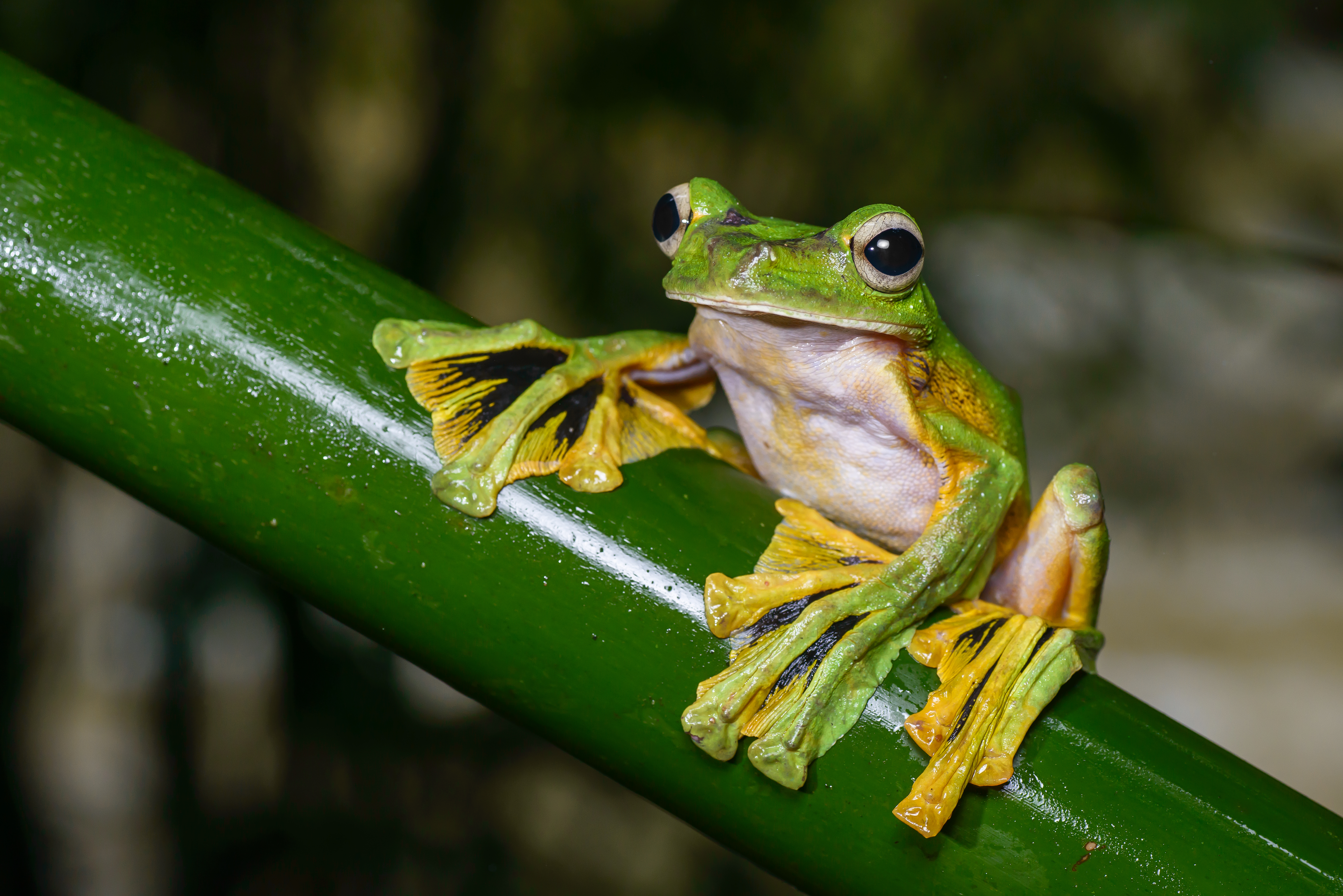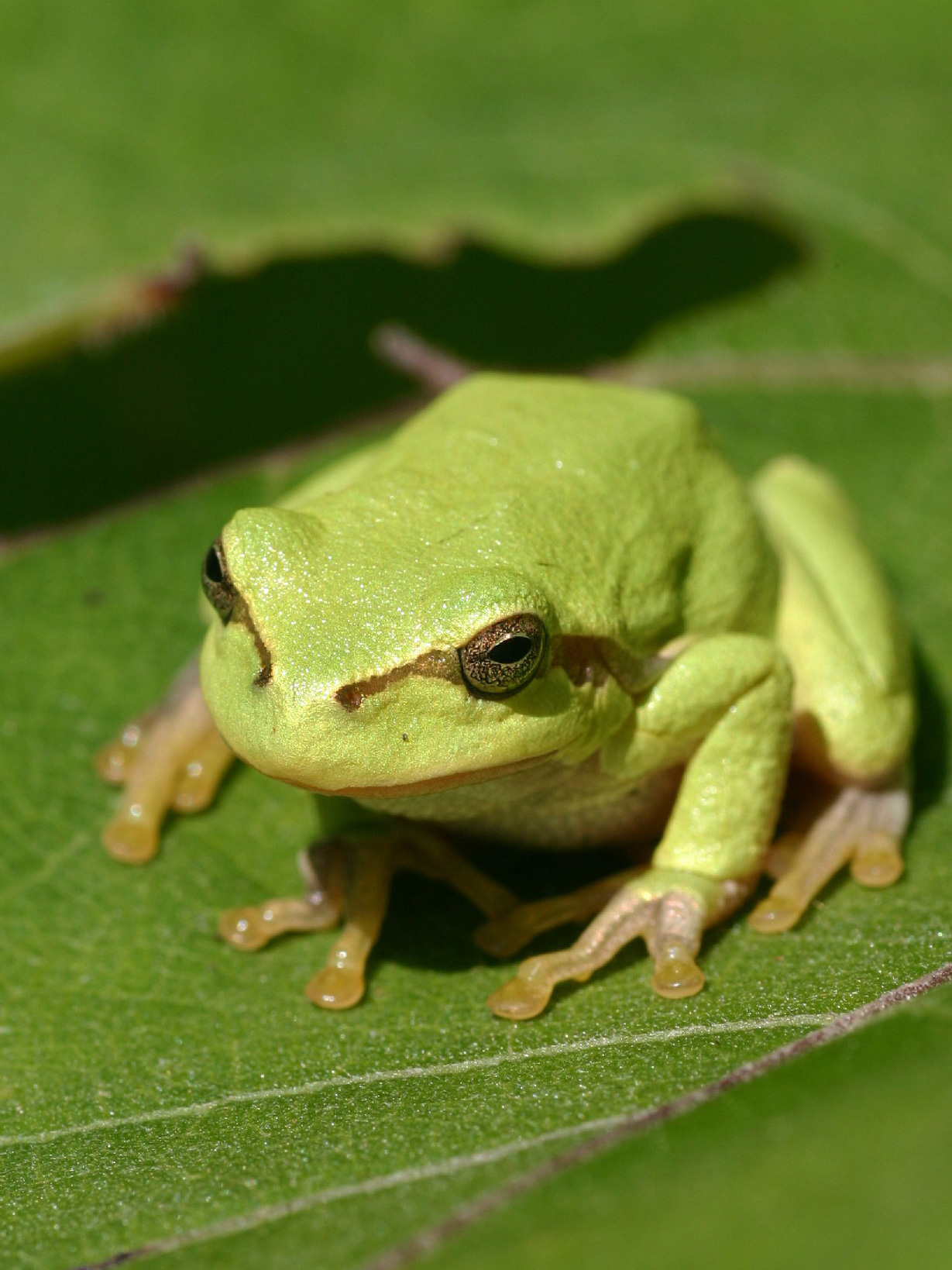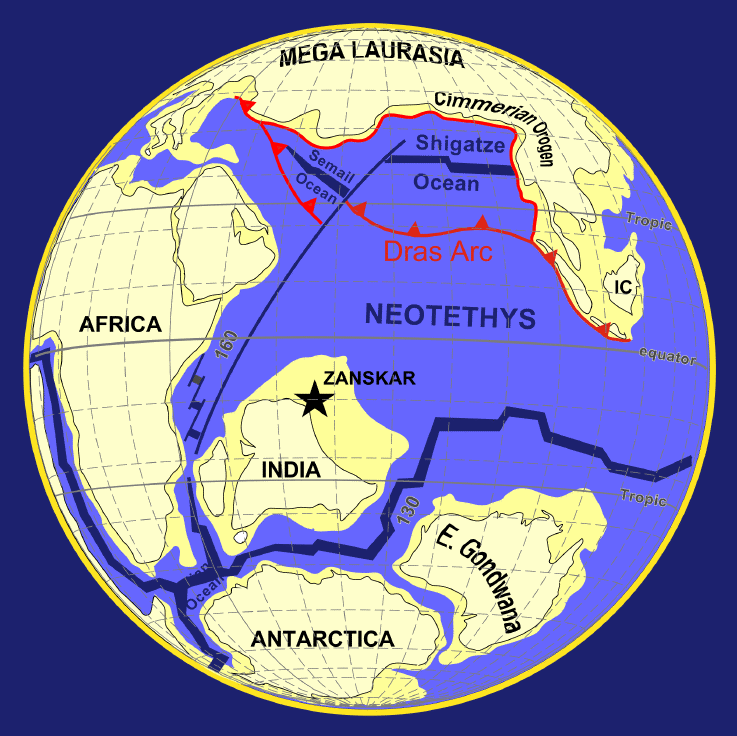|
Rhacophoridae
The Rhacophoridae are a family of frogs in tropical sub-Saharan Africa, South India and Sri Lanka, Japan, northeastern India to eastern China and Taiwan, south through the Philippines and Greater Sundas, and Sulawesi. They are commonly known as shrub frogs, or more ambiguously as " moss frogs" or " bush frogs". Some Rhacophoridae are called "tree frogs". Among the most spectacular members of this family are numerous " flying frogs". Although a few groups are primarily terrestrial, rhacophorids are predominantly arboreal treefrogs. Mating frogs, while in amplexus, hold on to a branch, and beat their legs to form a foam. The eggs are laid in the foam and covered with seminal fluid before the foam hardens into a protective casing. In certain species, this process occurs collectively. The foam is deposited above a water source, ensuring that the tadpoles drop into the water upon hatching. The species within this family vary in size from . Like other arboreal frogs, they have toe di ... [...More Info...] [...Related Items...] OR: [Wikipedia] [Google] [Baidu] |
Rhacophorinae
The Rhacophorinae are a subfamily of frogs in the family Rhacophoridae. They range from tropical Africa and Asia to temperate China and Japan. Genera The following genera are recognised in the subfamily Rhacophorinae, representing 422 species: * ''Beddomixalus'' Abraham, Pyron, Ansil, Zachariah, and Zachariah, 2013 (monotypic) * ''Chirixalus'' Boulenger, 1893 (six species) * ''Chiromantis'' Peters, 1854 (four species) * ''Feihyla'' Frost, Grant, Faivovich, Bain, Haas, Haddad, de Sá, Channing, Wilkinson, Donnellan, Raxworthy, Campbell, Blotto, Moler, Drewes, Nussbaum, Lynch, Green, and Wheeler, 2006 (six species) * ''Ghatixalus'' Biju, Roelants, and Bossuyt, 2008 (three species) * ''Gracixalus'' Delorme, Dubois, Grosjean, and Ohler, 2005 (18 species) * ''Kurixalus'' Ye, Fei, and Dubois, 1999 (22 species) * ''Leptomantis'' Peters, 1867 (13 species) * ''Liuixalus'' Li, Che, Bain, Zhao Ermi, Zhao, and Zhang, 2008 (six species) * ''Mercurana'' Abraham ''et al''., 2013 (monotypic) * ' ... [...More Info...] [...Related Items...] OR: [Wikipedia] [Google] [Baidu] |
Frog
A frog is any member of a diverse and largely semiaquatic group of short-bodied, tailless amphibian vertebrates composing the order (biology), order Anura (coming from the Ancient Greek , literally 'without tail'). Frog species with rough skin texture due to wart-like parotoid glands tend to be called toads, but the distinction between frogs and toads is informal and purely cosmetic, not from taxonomy (biology), taxonomy or evolutionary history. Frogs are widely distributed, ranging from the tropics to subarctic regions, but the greatest concentration of species diversity is in tropical rainforest and associated wetlands. They account for around 88% of extant amphibian species, and are one of the five most diverse vertebrate orders. The oldest fossil "proto-frog" ''Triadobatrachus'' is known from the Early Triassic of Madagascar (250Myr, million years ago), but molecular clock, molecular clock dating suggests their divergent evolution, divergence from other amphibians may exte ... [...More Info...] [...Related Items...] OR: [Wikipedia] [Google] [Baidu] |
Chiromantis
''Chiromantis'' is a genus of frogs in the family Rhacophoridae, commonly known as foam-nest frogs or foam-nest tree frogs. It contains species from the Sub-Saharan African tropics. Following the molecular genetic study by Chen and colleagues (2020), the Asian species formerly assigned to ''Chiromantis'' have now been reclassified to the resurrected genus '' Chirixalus''. Description ''Chiromantis'' lay their eggs in terrestrial foam nests. Species The following species are recognised in the genus ''Chiromantis'': * '' Chiromantis kelleri'' Boettger, 1893 * '' Chiromantis petersii'' Boulenger, 1882 * '' Chiromantis rufescens'' (Günther, 1869) * ''Chiromantis xerampelina The grey foam-nest tree frog (''Chiromantis xerampelina''), or southern foam-nest tree frog, is a species of frog in the family Rhacophoridae. They are found in southern Africa. Its natural habitats are subtropical or tropical dry forest, dry sa ...'' Peters, 1854 References External links *Chiromantisat ... [...More Info...] [...Related Items...] OR: [Wikipedia] [Google] [Baidu] |
Buergeriinae
''Buergeria'' is a genus of frogs in the family Rhacophoridae, and the sole genus of subfamily Buergeriinae. It is the sister taxon for all the other rhacophorids (subfamily Rhacophorinae). The available genetic data firmly supports this position. ''Buergeria'' are sometimes known as Buerger's frogs. There are six species found in an area that stretches from Hainan (China) and Taiwan through the Ryukyu Islands to Honshu (Japan). Description ''Buergeria'' are medium-sized to large frogs (snout-vent length ) that resemble in their body form ''Rana'' (unlike other rhacophorids). Their skin is smooth and they have no dorsal ornamentations. Their feet are fully webbed whereas their fingers are only up to half-webbed. They produce many eggs that are deposited in water and develop through a tadpole stage. Species There are six recognized species in the genus ''Buergeria'': * '' Buergeria buergeri'' (Temminck & Schlegel, 1838) — Kajika Frog * '' Buergeria choui'' Matsui & Tominaga, 2 ... [...More Info...] [...Related Items...] OR: [Wikipedia] [Google] [Baidu] |
Flying Frog
A flying frog (also called a gliding frog) is a frog that has the ability to achieve gliding flight. This means it can descend at an angle less than 45° relative to the horizontal. Other nonflying arboreal frogs can also descend, but only at angles greater than 45°, which is referred to as parachuting.Emerson, S.B., Travis, J., & Koehl, M.A.R. (1990). "Functional complexes and additivity in performance: A test case with 'flying' frogs." ''Evolution'', 44(8), 2153-2157. Evolution Gliding flight has evolved independently several times among frogs from both New World ( Hylidae) and Old World ( Rhacophoridae) families.Emerson, S.B., & Koehl, M.A.R. (1990). "The interaction of behavioral and morphological change in the evolution of a novel locomotor type: 'Flying' frogs." ''Evolution'', 44(8), 1931-1946. This parallel evolution is seen as an adaptation to their life in trees, high above the ground. Characteristics of the Old-World species include "enlarged hands and feet, full ... [...More Info...] [...Related Items...] OR: [Wikipedia] [Google] [Baidu] |
Tree Frog
A tree frog (or treefrog) is any species of frog that spends a major portion of its lifespan in trees, known as an arboreal state. Several lineages of frogs among the Neobatrachia suborder have given rise to treefrogs, although they are not closely related to each other. Millions of years of convergent evolution have resulted in very similar morphology even in species that are not very closely related. Furthermore, tree frogs in seasonally arid environments have adapted an extra-epidermal layer of lipid and mucus as an evolutionary convergent response to accommodate the periodic dehydration stress. Description As the name implies, these frogs are typically found in trees or other high-growing vegetation. They do not normally descend to the ground, except to mate and spawn, though some build foam nests on leaves and rarely leave the trees at all as adults, and '' Eleutherodactylus'' has evolved direct development and therefore does not need water for a tadpole stage. Tree fr ... [...More Info...] [...Related Items...] OR: [Wikipedia] [Google] [Baidu] |
Rhacophorus Nigropalmatus
Wallace's flying frog (''Rhacophorus nigropalmatus''), also known as the gliding frog or the Abah River flying frog, is a moss frog found at least from the Malay Peninsula into western Indonesia and southern Thailand, and is present in Borneo and Sumatra. It is named for the biologist, Alfred R. Wallace, who collected the first known specimen. Taxonomy '' R. dennysii'', '' R. maximus'' and '' Polypedates feae'' were once contained within Wallace's flying frog as subspecies. Similar frogs also occur in Laos, Vietnam, Malaysia, Thailand and southern China; these may be ''R. nigropalmatus'' or an undescribed, closely related species. Description This frog is quite photogenic, due to its large size, brilliant colors, and interesting behavior. With a body length of about 80–100 mm (males are smaller than females), it is one of the largest species of '' Rhacophorus''. Its eardrums are large, as well as its eyes, which feature horizontal pupils. Its limbs are very long, an ... [...More Info...] [...Related Items...] OR: [Wikipedia] [Google] [Baidu] |
Insular India
Insular India was an isolated landmass which became the Indian subcontinent. Across the latter stages of the Cretaceous and most of the Paleocene, following the breakup of Gondwana, the Indian subcontinent remained an isolated landmass as the Indian Plate drifted across the Tethys Ocean, forming the Indian Ocean. The process of India's separation from Madagascar first began 88 million years ago, but complete isolation only occurred towards the end of the Maastrichtian, a process that has been suggested to be the creation of the Deccan Traps. Soon after, the land mass moved northward rather quickly, until contact with Asia was established 55 million years ago. Even then, both landmasses did not become fully united until around 35 million years ago, and periods of isolation occurred as recently as 24 million years ago. Thus, for a period of 53 million years India retained a degree of isolation, 11 of which it was a complete island continent. This allowed ... [...More Info...] [...Related Items...] OR: [Wikipedia] [Google] [Baidu] |
Moss Frog (other)
Moss frog may refer to: * ''Arthroleptella'', a genus of true frogs from southern Africa * Rhacophoridae The Rhacophoridae are a family of frogs in tropical sub-Saharan Africa, South India and Sri Lanka, Japan, northeastern India to eastern China and Taiwan, south through the Philippines and Greater Sundas, and Sulawesi. They are commonly known as ..., a family of the Old World Tropics * Moss froglet, ''Crinia nimbus'' {{disambiguation Animal common name disambiguation pages ... [...More Info...] [...Related Items...] OR: [Wikipedia] [Google] [Baidu] |
Bush Frog (other)
A bush frog belongs to either of two neobatrachian lineages, both found in sub-Saharan Africa and one also in Asia: * Hyperoliidae, a family of sub-Saharan Africa and the Madagascar region, also known as sedge frogs * Rhacophoridae The Rhacophoridae are a family of frogs in tropical sub-Saharan Africa, South India and Sri Lanka, Japan, northeastern India to eastern China and Taiwan, south through the Philippines and Greater Sundas, and Sulawesi. They are commonly known as ..., a family of the Old World Tropics {{disambiguation Animal common name disambiguation pages ... [...More Info...] [...Related Items...] OR: [Wikipedia] [Google] [Baidu] |
Sri Lanka
Sri Lanka, officially the Democratic Socialist Republic of Sri Lanka, also known historically as Ceylon, is an island country in South Asia. It lies in the Indian Ocean, southwest of the Bay of Bengal, separated from the Indian subcontinent, Indian peninsula by the Gulf of Mannar and the Palk Strait. It shares a maritime border with the Maldives in the southwest and India in the northwest. Sri Jayawardenepura Kotte is the legislative capital of Sri Lanka, while the largest city, Colombo, is the administrative and judicial capital which is the nation's political, financial and cultural centre. Kandy is the second-largest urban area and also the capital of the last native kingdom of Sri Lanka. The most spoken language Sinhala language, Sinhala, is spoken by the majority of the population (approximately 17 million). Tamil language, Tamil is also spoken by approximately five million people, making it the second most-spoken language in Sri Lanka. Sri Lanka has a population of appr ... [...More Info...] [...Related Items...] OR: [Wikipedia] [Google] [Baidu] |






